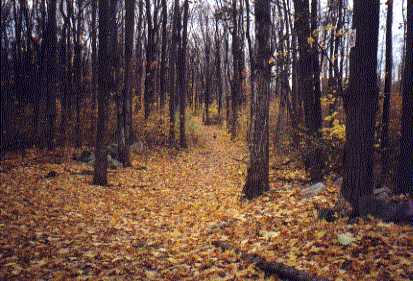ECOLOGICAL ASPECTS
OF THE MOLSON RESERVE
Introduction
The Molson Reserve is considered by many naturalists to be an exceptionally
diverse, rich natural community of animals and plants. There are no species
of animals on the island of Ile Perrot that do not occur elsewhere
in the province but the combination and diversity of species found in such
a confined space is unique (Lovrity, unpublished).
It is for these reasons that we chose to look at the ecological aspects
of the reserve. In particular, we focused our attention on data gathering
and to the proposal of an ecological monitoring scheme.
 Data
gathering is important for the collection and organization of past research
and information. Knowing what has been done in the past can help determine
what should be done in the future, without unnecessary repetition and cost.
Past research can help in the development of study design. In addition,
it permits comparison of current research with historical data allowing
researchers to detect ecological change.
Data
gathering is important for the collection and organization of past research
and information. Knowing what has been done in the past can help determine
what should be done in the future, without unnecessary repetition and cost.
Past research can help in the development of study design. In addition,
it permits comparison of current research with historical data allowing
researchers to detect ecological change.
Ecological monitoring is essential to determine if ecological integrity
is maintained or threatened. The objective of monitoring biodiversity is
to gain an understanding of what is changing in the ecosystem and why.
By integrating long-term information on species activity and density with
abiotic data such as soil and climate parameters, a profile of an ecosystem
can be prepared, and evidence of change recorded (EMAN,
1999). Furthermore, a monitoring scheme can validate the management
plan and can serve for educational research.
The biggest problem faced by managers is that not everything can be
monitored-there simply are not enough time and resources. The challenge
is to determine what to monitor and what resources are available. A well-organized
plan must be made but it must also be recognized that theory and reality
are not always in accordance. Thus the monitoring plan must be revisited
according to the features of the Molson Reserve. The main steps in the
proposal of a monitoring scheme are: the carrying out of inventories, the
development of base maps, and the systematic monitoring of identified parameters.

 Data
gathering is important for the collection and organization of past research
and information. Knowing what has been done in the past can help determine
what should be done in the future, without unnecessary repetition and cost.
Past research can help in the development of study design. In addition,
it permits comparison of current research with historical data allowing
researchers to detect ecological change.
Data
gathering is important for the collection and organization of past research
and information. Knowing what has been done in the past can help determine
what should be done in the future, without unnecessary repetition and cost.
Past research can help in the development of study design. In addition,
it permits comparison of current research with historical data allowing
researchers to detect ecological change.